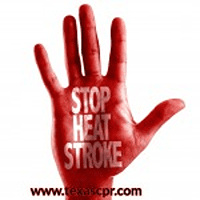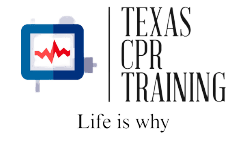
Heat Stroke
You wouldn’t think that knowing CPR is important when dealing with a heatstroke victim, but as with everything else, one adverse condition triggers another, which triggers another, and so on.
So when would CPR come into play with heatstroke? Unfortunately, it’s when you either don’t recognize the signs or don’t know how to treat it, and the victim becomes unconscious and stops breathing.
It seems obvious that heatstroke is a concern here in Texas, but you can also fall victim in cooler temperatures – Texas cool, that is – in the 70s and 80s. My sister had heatstroke when she was about 10 years old. I’m from England, and that is probably the last place you would think that could happen. But we had been out in the sun playing all day at the park. The temperature was only in the upper 70s, but it was enough for her to get heatstroke.
Heatstroke occurs when your body temperature rises rapidly and you’re unable to cool down. If not treated properly, it can be life-threatening by causing damage to your brain, muscles, heart, kidneys and other vital organs, and can even lead to death.
Strenuous activity in the heat or just being in a hot place for too long can bring it on. It is estimated that heat-related medical emergencies during sporting activities are ten times more prevalent than cardiac-related occurrences, which should be of particular concern for parents with children and teens practicing sports in the summer months.
Luckily, there are ways to prevent it and ways to treat it. It’s just a matter of taking precautions and being knowledgable to make sure you not only survive, but enjoy, the summer heat. Here is what to look for if you or someone you know starts to feel ill in the heat:
Signs and Symptoms of Heat Stroke
- Changes in mental status or behavior, such as confusion, agitation, slurred speech
- Hot, dry skin or heavy sweating
- Shivering
- Nausea and vomiting
- Flushed skin
- Rapid pulse
- Rapid breathing
- Headache
- Fainting, which may be the first sign in older adults
- Rectal temperature of 104 F (40 C) or greater
If you suspect a Heat Stroke
If you suspect heatstroke, call 911. Then immediately move the person out of the heat and cool him or her by whatever means available, such as:
- Remove as much unnecessary clothing as possible
- Put the person in a cool tub of water or a cool shower
- Spray with a garden hose
- Sponge with cool water
- Fan while misting with cool water
- Place ice packs or cool wet towels on the neck, armpits and groin
- Cover with cool damp sheets
- Do not give aspirin or acetaminophen to reduce body temperature
- If the person is awake and alert enough to swallow, give the person at least 32oz – 64oz of nonalcoholic, non-caffeinated fluids over a 1 – 2 hour period. Make sure they are sitting up enough so they do not choke
- Begin CPR if the person loses consciousness and shows no signs of circulation, such as breathing, coughing or movement
Of course, prevention is always better, so monitor yourself and loved ones in the heat. Drink plenty of fluids – preferably water; avoid alcohol, caffeine and sodas; wear light-colored, loose clothing; don’t overstay your welcome outdoors, and don’t stay outside just because everyone else is; use the shade.
Also, if you have children of your own, or have nephews and nieces, make sure that when they go their friend’s houses that those parents are aware of this. And also encourage them to learn CPR www.texascpr.com – your loved ones lives could be in their lives.
Articles on Heat Stroke
Uconn – University of Connecticut
Mayo Clinic
Safe Kids Worldwide
Kids Health
Wikipedia
Healthline
Learn more at Texas CPR Training, www.texascpr.com
Home 💙 CPR/First Aid/AED in person 💙 CPR/First Aid/AED virtually 💙 BLS Healthcare Provider CPR 💙 Become an American Heart Instructor 💙 About 💙 Gallery 💙 Blog 💙 Contact Us
